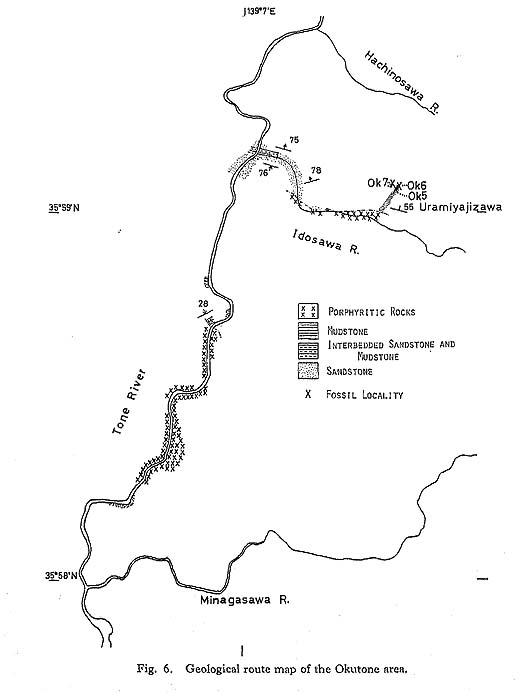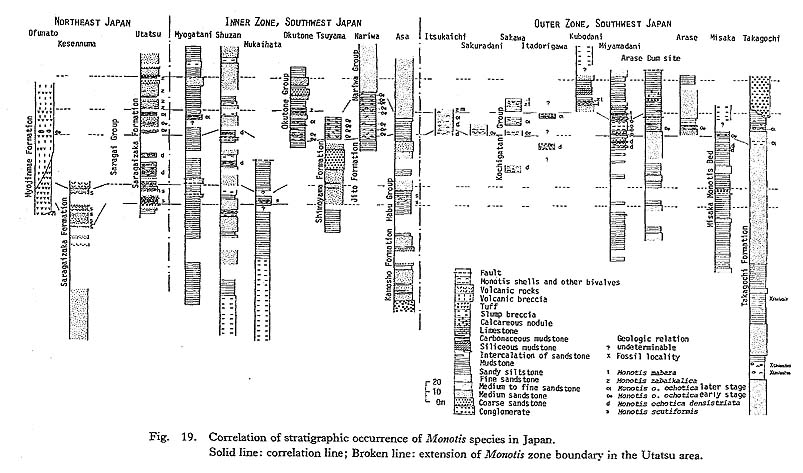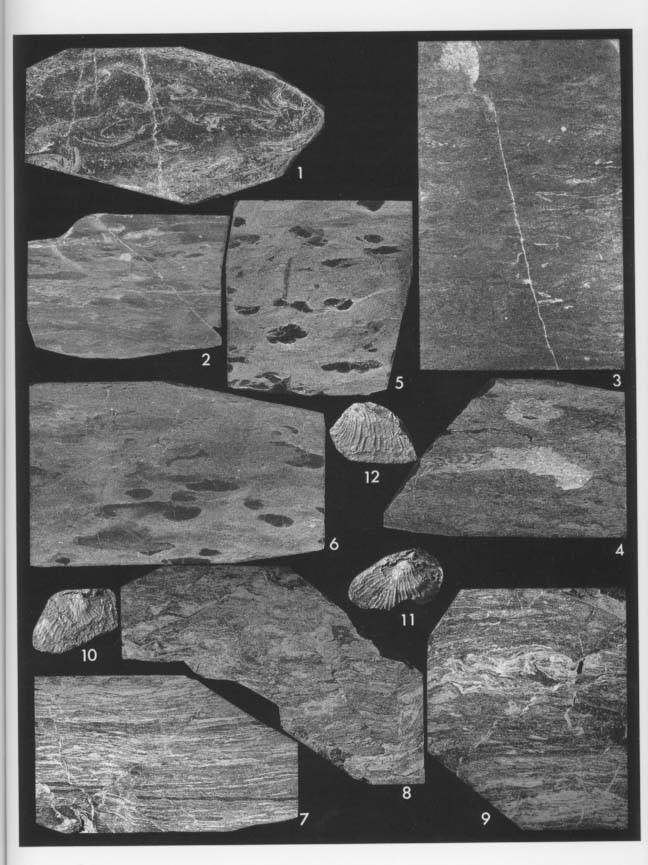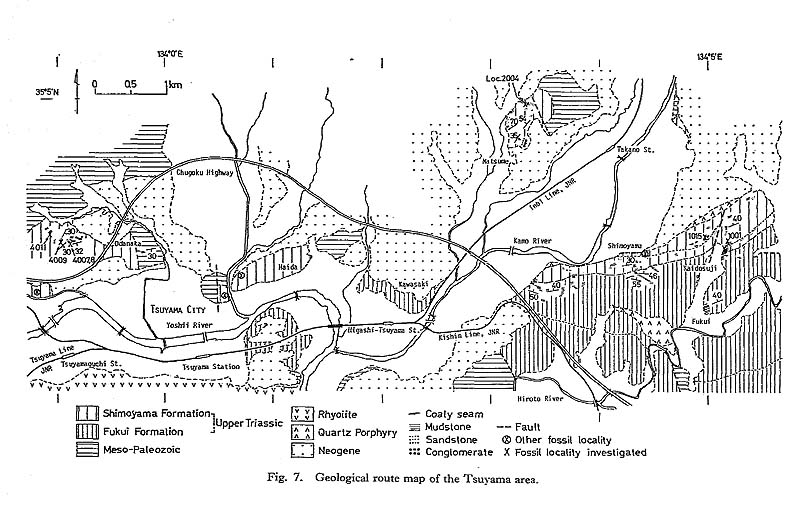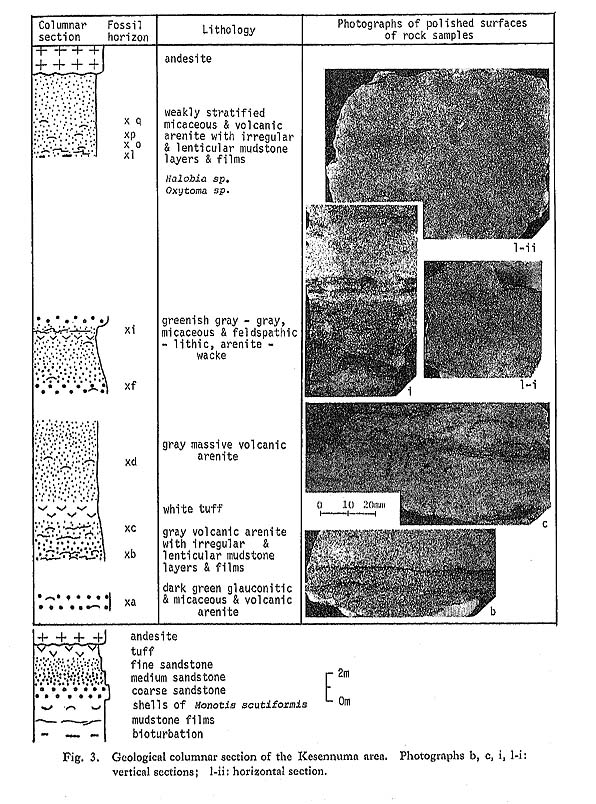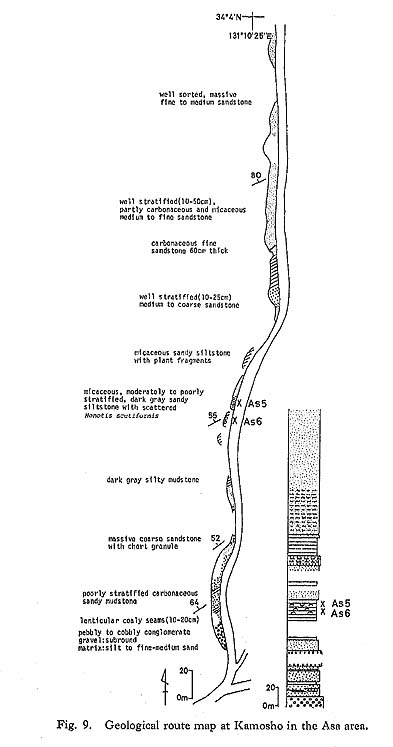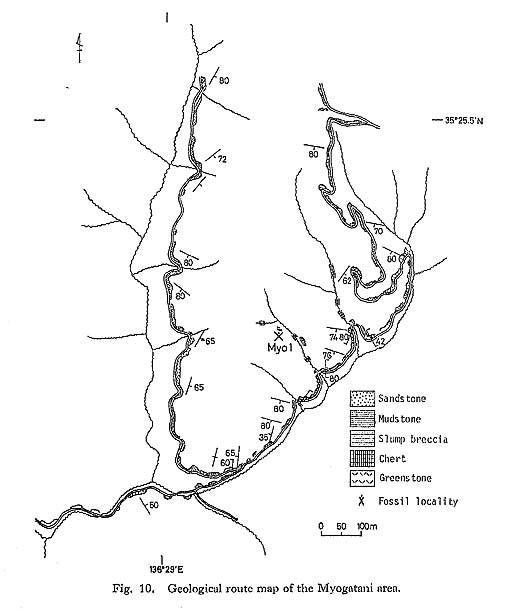CHAPTER 2
Geological Setting of Monotis-bearing Formations
2. Inner Zone of Southwest Japan (including Okutone Area)
|
The distribution of Monotis-bearmg formations in the Inner Zone of Southwest Japan is sporadic and shows hardly any zonal arrangement. Such formations can be divided into two facies for convenience, namely shallow-sea fades and "slump" facies. The former is found in the Okutone, Tsuyama, Nariwa and Asa areas, and the latter in the Myogatani, Shuzan and Mukaihata areas. The shallow-sea facies consists mainly of thick sequences of clastic rocks such as conglomerate, sandstone and mudstone, and subordinate coal seams. These rocks show several sedimentary cycles, representing changing environments including lake, deltaic and shallow shelf environments. Some of the formations are regarded as "Molasse" type deposits (e.g. Mine Group, Tokuyama, 1960, 1962). Monotis is contained only in the marine parts of the cycles. On the other hand, the Monotis-bearing formations of the "slump" facies, which have been thought to be rather offshore sediments, indicate a conspicuous contrast with those of the shallow-sea facies, Monotis layers occur only at one or a few horizons at a single locality as slump blocks or sediments closely associated with slump deposits. They are surrounded by shale without Monotis, or slump breccia dominated by a mud matrix and subordinate sandstone, chert, acid tuff and greenstone breccia. Furthermore, chert, limestone and basic volcanics beds arc found near the bed. Triassic conodonts and Triassic to Jurassic radiolarians have been detected from the matrix of the breccia or the slump deposits at various localities. In addition to the Monotis-bearing deposits, there is wide distribution of Triassic deposits dominated by chert, which are called chert faciea. No specimens of Monotis have been found in the chert facies. 2-1 Shallow-sea Facies1) Okutone Afea (Okutone Group)The Upper Triassic Okutone Group was named by lijima, Kobayashi and Sudo (1977). It is distributed in the upper reaches of the Tone River in the northern part of Gunma Prefecture, and consists of clastic deposits of shallow-sea facies. Kobayashi (1955) and Fujimoto and Yabe (1955) reported the occurrence of Monotis and the existence of Upper Triassic strata in this area. This area is very mountainous and some valleys are covered with snow even in midsummer. Therefore, the general geology and stratigraphy have not been fully clarified, lijima, Kobayashi and, Sudo (1977) and Kobayashi, lijima and Sudo (1978) divided the group into five formations. According to them, Monotis occurs in three horizons of the second lowest Oikkui Formation and the fourth Hongokusan Formation. The thickness between the upper and lower Monotisbearing horizons exceeds 1,000 meters. If compared with Monotis sequences in other areas, this is extraordinarily thick. The group is said to be mainly composed of massive to thickly bedded sandstone, interbedded sandstone and mudstone, and mudstone, including small amounts of slump breccia of the interbedded sandstone and mudstone. It rarely contains minor lenticular conglomerate and limestone which are a few meters thick. Several fossil localities of Monotis ochotica and M. zabaikalica have been found by the previous authors. In this study, however, samples were obtained only from the Urami-yajizawa Valley, a small branch of the Idosawa Valley which is in turn a tributary of the Tone River (Fig. 6). The samples treated here were obtained from three horizons of dark gray, partly sandy and somewhat micaceous or calcareous mudstone (Fig. 6, locs. Ok5, 6, 7; Fig. 19; Pl. 1, Fig. 5; Pl. 2, Fig. 2). This mudstone was subjected to weak contact metamorphism when the Okutone Granite was intruded.
2) Tsuyama Area (Shimoyama Formation)The occurrence of Monotis from the Tsuyama area, in the western extension of the Maizuru Belt, was first reported by Tsuboi (1916). Upper Triassic and so-called Paleo-Mesozoic strata are distributed in the Tsuyama Valley, surrounded by overlying Neogene strata. The former was named the Hirono Formation and subdivided into four members by Kawai (1957). But when Hase and Iwata (1971) restudied the stratigraphy and found a clino-unconformity in the Hirono Formation at Kaidosuji, east of Tsuyama City, they named the unit below the unconformity the Fukui Formation and the Monotis-bearing upper unit the Shimoyama Formation (Toyohara, 1977). According to Hase and Iwata (1971) and also my observation, the Upper Triassic formations in the Tsuyama area are described as follows (Fig. 7):
Shimoyama Formation Upper member <200 m Dark gray to grayish black, weakly fissile, partly micaceous, and clayey to sandy mudstone interbedded with medium- to fine-grained sandstone layers. Lower part of this member contains scattered M. ochotica ochotica shells. Their typical mode of occurrence can be observed at locality Ta1001, north of Kaidosuji, where a Monotis-bearing unit is about 20 meters in thickness. Lower member 50-200 m Granule-bearing coarse- to medium-grained, feldspathic, massive to thickly bedded sandstone, intercalated with some lenticular and discontinuous coal seams several centieters to a few meters thick. Without fossils. Fukui Formation Mainly dark gray to grayish black, fissile and laminated but partly massive, silty shale or mudstone with subordinate thin, fine-grained sandstone layers. Without fossils. The exposure of the unconformity between the two formations could not be observed in my study. Samples used in this study were obtained from the north of Kaidosuji (loc. Ta1001), Natsume (loc. Ts2004) and Odanaka (locs. Ts4007-9, 11; Nakazawa, 1951). 3) Nariwa Area (Jito Formation, Nariwa Group)The Nariwa area is famous for abundant occurrences of Monotis and plant fossils. Many studies on the geology and paleontology of this area have been completed; historical reviews were written by Kobayashi (1938), Kawai (1951), Tokuyama (1960, 1962), Bando (1964) and Otoh (1985). Invertebrate fossils, however, show low specific diversity in comparison with that of plants (Kobayashi and Ichikawa, 1952; Nakazawa, 1959, 1963). The Nariwa Group is considered to be lake, delta and shallow-sea deposits showing several sedimentary cycles. The lithology is similar to that of the Mine and liabu Groups in the Mine, Atsu and Asa areas. The group is distributed in belt trending NE-SW in the north and one trending ENE-WSW in the south, forming a southward arched triangular distribution (Fig. 8). The detailed stratigraphy was established by Kawai (1951), Teraoka (1959) and Kawai and Yoshimura (1962). According to Teraoka (1959), the Nariwa Group can be sub- divided into three formations, as follows :
Jito Formation >1000 m Upper member: partly granule-bearing medium- to coarse-grained sandstone, 100 to 150 meters thick, in the lower part. Fine-grained sandstone and mudstone, 250 meters thick, in the upper. Lower member: medium- to coarse-grained sandstone, 200 meters thick, in the upper part, interbedded sandstone and mudstone, 200 to 400 meters thick, in the lower. Plant fossils and coaly seams are rare. Monotis occurs sporadically almost throughout the member and abundantly in Eda (locs. Na4015), Jito (locs. Na1001, 1102) and southwesi. of Jito (loc. Nal560). Hinahata Formation >500 m Sandstone and mudstone interbedded with conglomerate. Abundant plant fossils in the mudstone. Mogamiyama Formation <700 m Conglomerate, sandstone, and mudstone occasionally with coaly seams. They constitute conspicuous sedimentary cycles at intervals of several to several tens of meters in thickness. With plant fossils. The stratigraphy of the group was established in a limited area of the southern part of Nariwa Town, and it is not yet confirmed whether it is applicable in other parts of the distribution. As to the atratigraphic distribution of Monotis, Nakazawa (1963) presented a list of Monotis species and subspecies from 9 horizons in one outcrop at Jito (loc. Na1001). No essential lithologic change is recognized within the sandy mudstone, 35 meters thick, at this locality. Based on the stratigraphic distribution of Monotis species and subspecies, this fossiliferoua interval as a whole was correlated with the S5 to S6 zones of Ichikawa. (1954b) or the C3 zone of Onuki and Bando (1958) in the Utatsu area, Northeast Japan. At another locality of Jito, M. ochotica densistriata was obtained and these strata were thought to be of the S4 zone of Ichikawa and the C2 zone of Onuki and Bando (1958). Although an excellent exposure was once observed at Jito, the greater part is now unfortunately concealed with sprayed concrete, so that the Monotis sequence reported by Nakazawa (1963) cannot be reexamined at this locality. But a good new sequence of sandy mudstone, 45 meters thick, was recently discovered in a small valley southwest of Jito (Fig. 8, loc. Na1560). Vertically continuous Monotis-bearing sections are scarce except for the two sections mentioned above. Kobayashi and Ichikawa (1952) reported besides Monotis, a few gastropod species, such as Naticopsis (s. 1.) sp. aff. Natica klipsteini and Naticella(?) infrequens, from Yama-moto (loc. Na4243). They described the following marine fossils from other localities: Lingula nariwaensis (loc. 2=loc. Na1003) and "Gervillia" cf. saekii, Edentula(?) triangularis and Cardinia misawaensis (loc. 3=loc. Na1002). The Monotis shells are generally contained in dark gray, micaceous, poorly laminated sandy mudstone or sandstone. For example, in Eda they occur in poorly sorted, bioturbated, poorly stratified, sandy mudstone (Pl. 2, Fig. 3).
4) Asa Area (Kamosho Formation, Habu Group)In the Mine, Atsu and Asa areas in the southwestern part of Yamaguchi Prefecture, Middle to Upper Triassic deltaic and shallow-sea deposits are widely distributed. They are composed of coarse-grained clastic sediments. In spite of the short time range, that is, from Ladinian to Norian, the total thickness of the strata attains a maximum of 6,000 meters. There have been many stratigraphic studies of this area. The basic stratigraphy was established by Hase (1951), Tokuyama (1958, 1962) and Takahashi et al. (1963). The first discovery of Monotis was reported by Kobayashi (1935) who identified Monotis subcycloidea. Among three basins (Mine, Atsu and Asa), Monotis occurs only in Asa. The Triassic strata in this area are divided into two groups by an unconformity in the middle part. The lower unit is the Tsubuda Group of Ladinian age, and the upper one the Habu Group of Carnian to Norian age. The stratigraphy of the latter is summarized as follows, according to Takahashi et al. (1963): KIII Member 200-400 m Mainly sandstone. Alternation of sandstone and mudstone in the lower and upper part. Abundant plant fossils. KII Member 270-540 m Dark gray to bluish gray, laminated, frequently micaceous, sandy mudstone or shale with intercalation of fine- to coarse-grained and partly conglomeratic sandstone and coaly seams. Monotis scutiformis, Tosapecten suzukii, are present. Trace fossils were found in a bed 20 meters above the Monotis-bearing horizon, and named Toyonereites eitaroi and T. eitaroi sanyoensis by Katto (1962). KI Member 150-280 m Medium- to coarse-grained massive sandstone. Yamanoi Formation 1300 m Conglomeratic sandstone, sandstone and mudstone of non-marine and shallow inner bay facies, with abundant plant fossils and estherians. Nakatsuka Formation 800-1200 m Sandstone, sandy mudstone, grayish black mudstone and interbedded sandstone and mudstone of shallow-sea facies. Several marine molluscs, such as Halobia sp., Tosafecten suzukii, Oxytoma sp., Asoella nakatsukensis and some plant fossils occur. Tsubuda Group (Ladinian) Idegami Formation 700-1000 m Hiramatsu Formation 1000 m Figure 9 shows a route map at Kamosho where M. scutiformis is found scattered throughout a sandy mudstone, about 10 meters thick.
2-2 "Slump" Fades1) Myogatani Area (Myogatani Formation) The Late Triassic age of the Myogatani Formation has been one of the best established in the Mino-Tamba Belt since discovery of Monotis by Wakimizu (1920). Although several geologic studies were carried out by Seki (1939, 1951), lsomi (1956), lchikawa et al. (1961) and Adachi (1976), a detailed and reliable stratigraphy of this area has not been established. It was generally thought that the Myogatani Formation was exposed as a kind of Schuppe bounded by the so-called 'Upper Paleozoic' in fault relation. Monotis ochotica shells occur mostly as fragments in micaceous, poorly laminated sandy mudstone or fine- to medium-grained sandstone (Fig. 10). As the sandstone bears mud patches or films, the shell fragments are thought to have been swept into aggre-gations under unstable conditions. The fossiliferous sandstone and mudstone are surrounded by unfossiliferous mudstone. Because the exposure is limited, the relation between the fossiliferous and unfossiliferous beds cannot be determined. The unfossiliferous mudstone in part includes slump breccia with lenticular sandstone clasts of various sizes, from a few millimeters to several meters in diameter. The lithologic difference between the fossiliferous layer and the surrounding strata suggests different sedimentary environments.
2) Shuzan Area ("Tamba" Group)The Tamba Group widely distributed in the Tamba Belt consists of strata of different ages, Carboniferous to Jurassic, and is composed of greenstone, chert and clastic rocks. The stratigraphy is very complicated and olistostromes of various kinds of lithology are contained in this group (Ishiga et al., 1981; Shimonishi et al., 1981). Molluscan fossils rarely occur in the olistoliths of conodont-bearing limestone. Such examples as reported by Nakazawa and Nogami (1967) from the western hills of Kyoto, and by Nakazawa and Shimizu (1955) from the north of Himeji, are possible cases. The Shuzan area is located on the southern limb of the Shuzan Synform which is one of the east-west trending folds in the Tamba Belt. Near the fossil localities, massive fine- to medium-grained sandstone is interbedded with slump breccia composed mainly of sandstone and subordinate amounts of chert, acid or basic tuff breccia (Fig. 11).
During my survey Monotis ochotica densistriata was obtained from two horizons. The lower fossil bed (loc. Sh2) consists of sandy laminated mudstone or thin alternations, about 3 meters thick, of muddy and subordinate sandy laminae. This bed contains scattered poorly preserved Monotis shells, but in some parts there are patches with crowded shells. The laminae of the bed are conspicuous and irregularly lenticular, discontinuous, and wavy (Pl. 2, Figs. 7-9). A small slump structure with minor slump faults was observed (Pl. 2, Fig. 8). The Monoid-bearing layer gradually grades into unfossiliferous slump breccia including microbreccias, both upward and downward, without a sudden lithologic change. The upper fossil bed is located stratigraphically at several tens of meters above the lower bed, but the surrounding beds near the horizon are cut by several faults, so the precise stratigraphic position cannot be given. The Monotis-bearing part consists of a lens of sandy mudstone with crowded shells, 25 centimeters in maximum thickness and 65 centimeters in width, which is sharply bounded by unfossiliferous mudstone. Many Monotis shells of the upper fossil bed are also fragmentary and strongly deformed; complete individuals are scarce. Whether the Monotis shells were deposited in situ in the lens or are contained in exotic blocks in the breccia, needs further detailed study. 3) Mukaihata Area (Mukaihata Formation)So-called Paleo-Mesozoic strata composed of mudstone, chert, sandstone and slump breccia are distributed in eastern Yamaguchi Prefecture. Hase (1961) discovered Monotis in sandy mudstone at Mukaihata. Toyohara (1977) described the detailed stratigraphy of the Mukaihata area with biostratigraphical data from conodonts, and discussed tectonic development of West Chugoku including this area. It is now necessary to restudy the stratigraphy around the Monotis locality, especially the "unfossiliferous" strata in terms of radiolarian biostratigraphy, because there is a possibility that the Monotis-bearing formation is a large slump block in the slump breccia whose matrix may be Jurassic in age (Hayasaka et al., 1983). But unfortunately geological investigation and fossil collecting at the fossil locality are impossible now as the exposure was almost buried under a landslide due to dam construction. The surrounding strata near the locality are muddy slump deposits with mega- and micro-breccias of chert, basic volcanics and sandstone. In this paper, Toyohara's stratigraphical succession is used in conjunction with my own additional investigation. The Monotis specimens collected by Hase were examined with his permission. They were obtained from a gray to light gray, partly silicified, sandy mudstone. There is strong secondary deformation of the specimens, but several complete individuals are present. |
